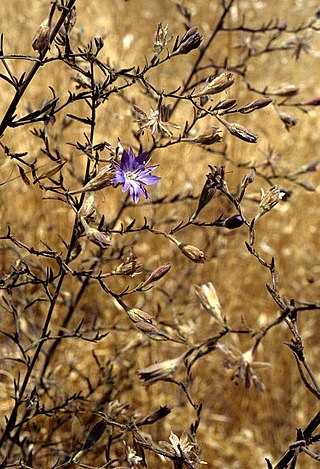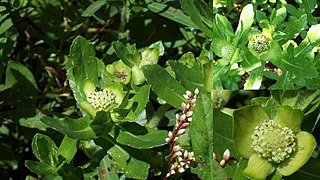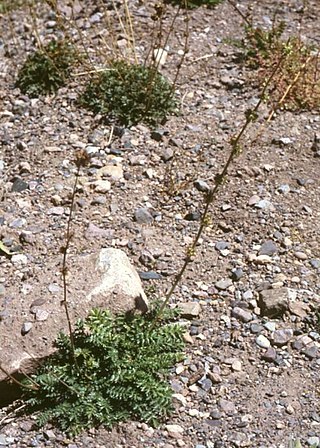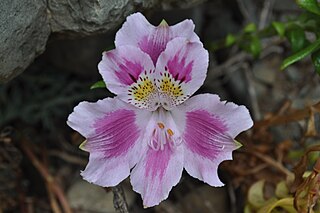
Trillium erectum, the red trillium, also known as wake robin, purple trillium, bethroot, or stinking benjamin, is a species of flowering plant in the family Melanthiaceae. The plant takes its common name "wake robin" by analogy with the European robin, which has a red breast heralding spring. Likewise Trillium erectum is a spring ephemeral plant whose life-cycle is synchronized with that of the forests in which it lives. It is native to the eastern United States and eastern Canada from northern Georgia to Quebec and New Brunswick.

Stelis, or leach orchids, is a large genus of orchids, with perhaps 500 species. The generic name Stelis is the Greek word for 'mistletoe', referring to the epiphytic habit of these species. These mainly epiphytic plants are widely distributed throughout much of South America, Central America, Mexico, the West Indies and Florida. Stelis is abbreviated Ste. in the horticultural trade.

Lapageria is a genus of flowering plants with only one known species, Lapageria rosea, commonly known as Chilean bellflower or copihue. Lapageria rosea is endemic to Chile and it is the national flower of this country. It grows in forests in the southern part of Chile, being part of the Valdivian temperate rainforests ecoregion flora.

Alstroemeriaceae is a family of flowering plants, with 254 known species in four genera, almost entirely native to the Americas, from Central America to southern South America. One species of Luzuriaga occurs in New Zealand, and the genus Drymophila is endemic to south-eastern Australia.

Alonsoa is a genus of 12 species of flowering plants in the family Scrophulariaceae. The genus includes both herbaceous and shrubby species.

Malesherbia is a genus of flowering plants consisting of 25 species in the Passifloraceae. This is a xerophytic group endemic to the Peruvian and Chilean deserts and adjacent Argentina. The genus is currently recognized by the APG III system of classification in the family Passifloraceae, and is the sole member of the subfamily Malesherbioideae.

Heliconia rostrata, the hanging lobster claw or false bird of paradise, is a herbaceous perennial plant native to El Salvador, Peru, Bolivia, Colombia, Venezuela, Costa Rica, and Ecuador, and naturalized in Puerto Rico. The inflorescences of many other heliconias grow vertically, facing upwards, their cup-shaped bracts storing water for birds and insects. This plant, however, has pendulous inflorescences with the bracts facing downwards, the flowers nestled underneath. Without the collection of rainwater in the bracts, the flowers within them provide a source of undiluted nectar.

Nomocharis was a genus of flowering plants in the family Liliaceae. It consisted of about 7 species native to montane regions of western China, Myanmar, and northern India. They are similar to Lilium, with one of the more obvious differences being the flowers being more shallow or sometimes flat.

Hipólito Ruiz López, or Hipólito Ruiz, was a Spanish botanist known for researching the floras of Peru and Chile during an expedition under Carlos III from 1777 to 1788. During the reign of Carlos III, three major botanical expeditions were sent to the New World; Ruiz and José Antonio Pavón Jiménez were the botanists for the first of these expeditions, to Peru and Chile.

Sessea is a genus of 19 accepted species of shrubs, small trees and climbers belonging to the subfamily Cestroideae of the plant family Solanaceae. The flowers of Sessea are so similar to those of Cestrum that the genera cannot usually be told apart, unless the plants are in fruit. Then their distinguishing characteristics become immediately apparent; plants of the genus Sessea bearing dehiscent capsules dispersing winged seeds, while those belonging to the genus Cestrum bear juicy berries containing prismatic seeds. The flowers of both Sessea and Cestrum have tubular corollas that are long exserted from small calyces.

José Antonio Pavón Jiménez or José Antonio Pavón was a Spanish botanist known for researching the flora of Peru and Chile.

Conanthera is a genus of small bulbous plants with small panicles of blue, purple or white and purple flowers. Propagation is by offsets or seed. All species are native to Chile, but there is an old 18th-Century report of C. bifolia occurring in colonial Peru as well. This could possibly be attributed to changes in boundaries between the two countries, as modern sources list the species as endemic to Chile.
- Conanthera bifoliaRuiz & Pav. - from Valparaíso to La Araucanía
- Conanthera campanulataLindl. - from Antofagasta to La Araucanía
- Conanthera parvula(Phil.) Muñoz-Schick - from Valparaíso to La Araucanía
- Conanthera trimaculata(D.Don) F.Meigen - central Chile
- Conanthera urceolataRavenna - Atacama

Enydra is a genus of flowering plants in the Asteraceae, or daisy, family. They are native to the Asian, African and American Tropics and Sub-Tropics.

Acaena pinnatifida, known by the common names Argentinian biddy-biddy and California sheepbur, is a species of plant. It is known from California and in Argentina and Chile. The population from California is sometimes considered to be a distinct species or variety from the population in South America.
The Botanical Expedition to the Viceroyalty of Peru was a Spanish expedition to the colonial territories of the Viceroyalty of Peru and Chile between 1777 and 1788.

Cosmibuena is a genus of flowering plants in the family Rubiaceae. The genus is native to Chiapas, Central America, and South America as far south as Brazil.

Hippeastrum miniatum is a flowering perennial herbaceous bulbous plant, in the family Amaryllidaceae, native to Peru.
Berberis flexuosa is a shrub in the Berberidaceae described as a species in 1802. It is endemic to Peru.

Alstroemeria pelegrina, the Peruvian lily, is a species of flowering plant in the large genus Alstroemeria of the family Alstroemeriaceae (Inca-lilies), part of the monocot order Liliales. It is the type-species of that genus, originally described by Linnaeus in 1762 as one of three species of Alstroemeria. It is a herbaceous rhizomatous perennial endemic to Chile.

















